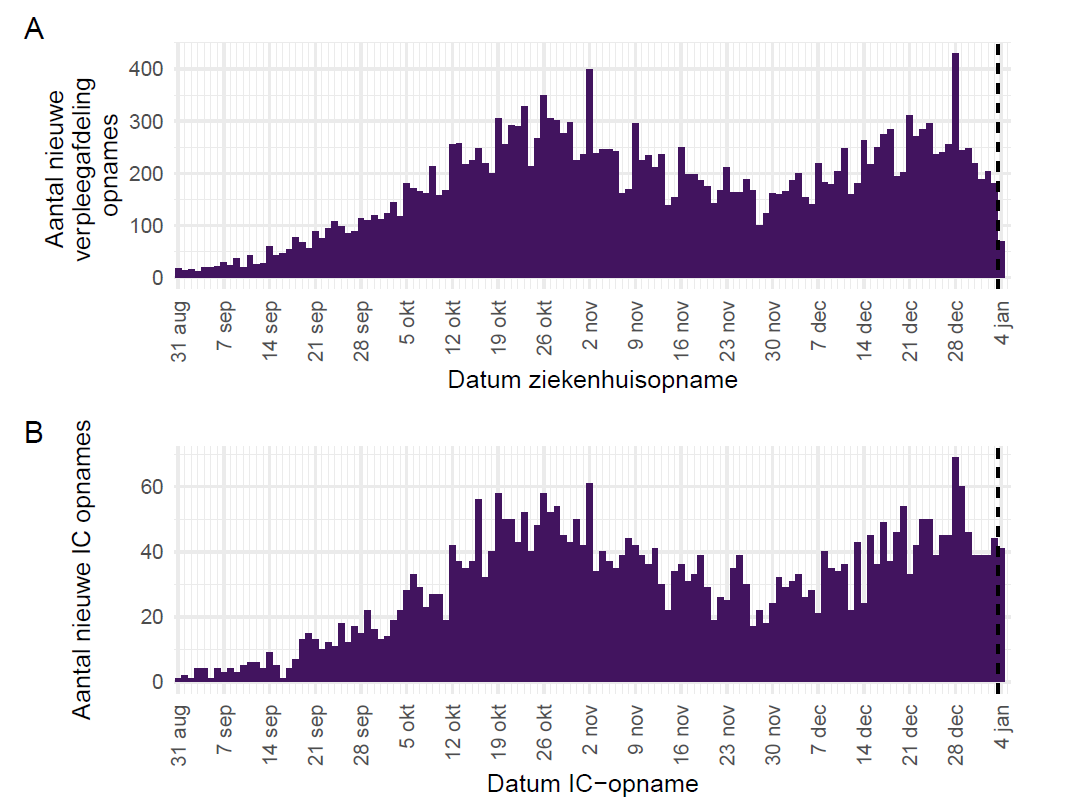
Decisive effects from the lockdown of 15 December in the Netherlands have yet to be seen. Although there was a decrease in the number of people who were tested and the number of people who tested positive for COVID-19, the percentage of positive tests remained high this week. It is possible that people were less inclined to get tested during and after the holidays, or that the lockdown is having an effect and fewer people are showing symptoms. The number of new hospital admissions was lower than in the previous week; the number of new ICU admissions increased somewhat.
Reported figures
In the past week, from 30 December to 5 January, the reported number of people who tested positive for COVID-19 was 56,440. This reported number is a decrease of 16.2% compared to the week of 23 to 29 December when there were 67,388 newly reported infections. For the second week in a row, the number of people who were tested decreased compared to the week before that (-16%). The number of people who were tested in the last calendar week was 368,126, a decrease of more than 70,500 tests compared to the week of 21 to 27 December. The percentage of people who tested positive for COVID-19 remained high, rising from 13.0% to 13.7% last week.
The number of newly reported infections per capita remains high in all security regions – particularly in the Twente security region, which had the highest number of newly reported infections per 100,000 inhabitants as well as the highest percentage of positive tests in the past week (Figure 1). The number of newly reported COVID-19 infections per 100,000 inhabitants remained stable compared to the week before in the security regions of Zaanstreek-Waterland, Drenthe and Fryslân. The other security regions showed a decrease compared to the week before.
Figure 1. Left: the number of positive COVID-19 tests reported by the GGD per security region last week (30 December-3 January). Right: the percentage (%) of positive tests in the GGD test lanes per security region in the past calendar week (28 December-3 January).
There was a decrease in the number of reported infections in all age groups last week compared to the week before (Figure 2). The largest decrease in the number of reported infections per 100,000 people was in the age group of 13-17 years. This age group also showed the largest decrease in the number of tests taken.
Figure 2. Number of reported positive tests per age category per week.
Hospital admissions and ICU admissions
In the week of 28 December to 3 January, 1,713 new people were admitted to the nursing wards of hospitals with COVID-19. This was a slight decrease of 179 (-9.5%) admissions compared to the week before that. In the week of 28 December to 3 January, there were 336 new patients who became so ill that they had to be transferred to intensive care. That is about 10% higher than the week before, when 304 new ICU admissions were reported (Figure 3).
Figure 3. (A) Number of new COVID-19 patients per day in Dutch* nursing wards. (B) Number of COVID-19 patients per day in Dutch* intensive care units. Source: NICE Foundation
*Including admissions to German ICUs when Dutch ICUs were over capacity.
Reproduction number and number of contagious people
The reproduction number** on 18 December, right after the start of the lockdown that was implemented on 15 December, decreased compared to the week before, dropping from 1.15 (lower limit 1.12 and upper limit 1.17) to 0.91 (lower limit 0.89 and upper limit 0.92), based on the number of reports of people with a positive test result. A reproduction number of 0.91 means that 100 people will collectively infect another 91 people with the virus.
The number of contagious people*** in the Netherlands has risen. On 24 December, there were more than 172,000 people in the Netherlands who were contagious for the coronavirus SARS-CoV-2 (lower limit 127,000, upper limit 216,000). This is an increase of 7,000 contagious people compared to the week before that.
The UK coronavirus variant in the Netherlands
The UK variant of the coronavirus SARS-CoV-2 has been found at a number of locations in the Netherlands. This variant seems to be more contagious, but the latest information indicates that the course of illness is no different from the variant most commonly found in the Netherlands. GGD Rotterdam, Erasmus MC and RIVM are researching the UK variant; the results are expected shortly. The current measures in the Netherlands are important to prevent the spread of the coronavirus (SARS-CoV-2), regardless of which variant it is.
Follow the measures!
The virus spreads at every possible opportunity. In order to reduce pressure on the healthcare system, it continues to be necessary to stay at home as much as possible and, if you have symptoms that could indicate COVID-19, to stay home and get tested. To slow the continued spread of the virus, it is important for everyone to comply with the measures and the basic rules. Stay at least 1.5 metres from others. Stay home as much as possible, and minimise the number of people you have contact with. Work from home. If you have symptoms, stay home and get tested. Wash your hands frequently, especially when you arrive somewhere from outside.
Open data
RIVM publishes open data that is accessible to everyone every day around 15.15 hrs (3:15 PM).
**The estimates for R from longer than 14 days ago are reliable. An estimated R based on data from less than 14 days ago involves more uncertainties. That is why we always look at the R from 14 days ago.
**The estimates for the number of contagious people from longer than 7 days ago are reliable. Estimates for the number of contagious people based on data from less than 7 days ago involves more uncertainties. That is why we always look at the number of contagious people from 7 days ago.
| Last week1 | Two weeks ago2 | |
|---|---|---|
| Reports of people with a positive test result coronavirus SARS-CoV-2 | ||
| Newly reported COVID-19 infections | 56,440 | 67,388 |
| Hospital admissions to nursing wards (Source: NICE)3 | 1,713 | 1,892 |
| Hospital admissions to Intensive Care (Source: NICE)3 | 336 | 304 |
| Deaths | 621 | 583 |
| GGD test lanes per calendar week4 | week 53 | week 52 |
| Total number of tests of which results are known | 349,417 | 410,584 |
| Number of people who tested positive | 47,743 | 53,398 |
| Percentage of positive tests | 13,7% | 13,0% |
Not all of the reported hospital admissions or deaths occurred within the last 24 hours
¹ GGD reports to RIVM between 29 December 10:01 and 5 January 10:00 as published 5 January 2021 in the weekly epidemiological update on SARS-CoV-2 in the Netherlands.
² GGD reports to RIVM between 22 December 10:01 and 29 December 10:00 as published 29 December 2020 in the weekly epidemiological update on SARS-CoV-2 in the Netherlands.
3 As published 5 January 2021 in the weekly epidemiological update on SARS-CoV-2 in the Netherlands. The figures from the past week and current week may be updated to include any registrations provided later by the NICE Foundation.
4 As published 5 January 2021 in the weekly epidemiological update on SARS-CoV-2 in the Netherlands. The figures from the past week and current week may be updated to include any test results provided later.

